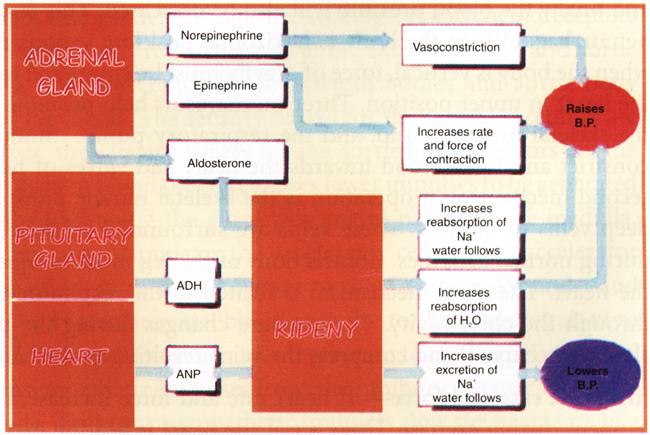Because blood pressure is so important, many physiological factors and processes interact to keep blood pressure within normal limits:
(i) Venous return - known as the amount of blood that comes back to the heart by way of the veins. Venous return is important because the heart can pump only the blood it receives. If venous return is less, the cardiac muscle fibres will be less stretched and the force of ventricular systole will decrease and finally the blood pressure will also be decreased. This is what might happen following a severe hemorrhage. When the body is horizontal position, venous return is maintained fairly easily, but when the body is vertical, force of gravity must be countered to return blood from the lower body to the heart in upper position. Three mechanisms help promote venous return: constriction of veins, the skeletal muscle pump, and the respiratory pump. Smooth muscles of vein enables them to constrict and force blood towards the heart and valves of heart prevent back flow of blood. The second mechanism at operation is the skeletal muscle pump, which is especially effective for the deep veins of the legs. These veins are surrounded by skeletal muscles. They contract and relax during normal activities. Contractions of the leg muscles squeeze the veins to force blood towards the heart. The third mechanism is related to the respiratory pump, which affects veins that pass through the chest cavity. The pressure changes during the process of inhalation and exhalation alternately expand and compress the veins resulting in the blood returned to the heart.
(ii) Heart rate and force - If heart rate and force increase, blood pressure increases; that is what happens during exercise. However, if the heart is beating extremely rapidly, the ventricles may not fill completely between beats, and cardiac output and blood pressure will decrease.
(iii) Peripheral resistance - It refers to the resistance the vessels offer to the flow of blood. The arteries and veins are usually slightly constricted, which maintains normal diastolic blood pressure. It may be helpful to think of the vessels as the "container" for the blood.
(iv) Elasticity of the large arteries - As and when the left ventricle contracts, the blood that enters the large arteries stretches their walls. The arterial walls are elastic and absorb some of the force. When the left ventricle relaxes, the arterial walls recoil or snap back, which helps keep diastolic pressure within the normal range. Normal elasticity, therefore, lowers systolic pressure, raises diastolic pressure, and maintains a normal pulse pressure. (Pulse pressure is the difference between systolic and diastolic pressure. The usual ratio of systolic to diastolic to pulse pressure is approximately 3:2:1. For example, with a blood pressure of 120/80 mmHg, the pulse pressure is 40, and the ratio is 120:80:40, or 3:2:1.)
(v) Viscosity of the blood - Blood viscosity depends upon the presence of red blood cells and plasma proteins, especially albumin. Having too many red blood cells is rare but does occur in the disorder called polycythaemia Vera and in people who are heavy smokers. This will increase blood viscosity and blood pressure. A decreased number of red blood cells, as is seen with severe anaemia, or decreased albumin, as may occur in liver disease or kidney disease, will decrease blood viscosity and blood pressure. In these situations, other mechanisms such as vasoconstriction will maintain blood pressure as close to normal as is possible.
(vi) Loss of blood - There is a small loss of blood, as when donating a pint of blood. It causes a temporary drop in blood pressure followed by rapid compensation in the form of a more rapid heart rate and greater vasoconstriction. However after a severe hemorrhage such compensating mechanisms may not be - efficient to maintain normal blood pressure. Survival of a person is possible up to loss of 50% of the body's total blood but possibility of brain damage increases as more blood is lost.
(vii) Hormones - Hormonal profiles also influence the blood pressure (Fig. 1-6). The Medulla part of Adrenal gland secretes norepinephrine and epinephrine in stressful situations. Increase of Norepinephrine serection causes vasoconstriction, which results in rise in blood pressure. Epinephrine also causes vasoconstriction, which again increases heart rate and force of contraction, both together increase blood pressure. Antidiuretic hormone (ADH) is secreted by the posterior pituitary gland when the water content of the body decreases. ADH increases the reabsorption of water by the kidneys to prevent further loss of water in urine, which add to further decrease in blood pressure. Aldosterone, a hormone secreted from the cortex part of Adrenal gland has a similar effect on blood volume. When blood pressure decreases, secretion of aldosterone stimulates the reabsorption of Na ions by the kidneys. Water follows sodium back to the blood, which maintains blood volume to prevent a further drop in blood pressure. Atrial natriuretic peptide (ANP), secreted by the atria of the heart, functions in opposition to aldosterone. ANP increases the excretion of Na~ ions and water by the kidneys, which decreases blood volume and lowers blood pressure.

Fig. 1-6. Hormones that affect blood pressure.
 Prof. J.P.N. Mishra
Prof. J.P.N. Mishra
